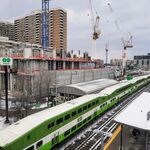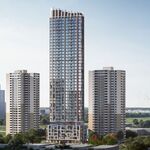ssiguy, I'm not sure what you are saying, but what I think you intended to say is: "ROW alone does not make LRT rapid. Station spacing is also important. Transit City failed to emphasize travel speed because stations were too close together. LRT is no better than BRT."
Perhaps what's more important than whether something is considered "LRT" or "Subway" are metrics like passenger-kilometres (or passenger miles), ridership, headways, capital costs, etc., because these tell us how well a system is providing access, connecting citizens to opportunities and each other, unlocking land values, reducing congestion, and providing happiness (whatever that is) to citizens and visitors. Isn't that the point of rapid transit anyway? Speaking of "rapid", this is another tricky term to define. Typically, if we build our systems assuming people will walk up to a certain distance (say, 800m), then logically we often say we get the most value spacing stations at 1.5-1.6 km. It is these station spacings with a separated ROW that limits travel speed - not technology!
Want a system that is truly "rapid", space stations far enough apart to achieve those 80-100 km/h top speeds. Of course, this highly limits accessibility and you are going to build more track to serve fewer people. I agree with ssiguy that an EXPRESS subway or LRT route with 4-5 km spacing would be useful in the GTA. However, there is an economic theory of transit that first a region needs to provide network access. I think Eglington should have had stoptrein and sneltrein - 4 tracks. By the way, the Crosstown LRT is about the same distance as Den Hague to Rotterdam with about the same population density, so why didn't we copy what worked for them?
What about ridership limitations? Is it true that "heavy rail" (i.e. Metro or Subway) can carry more people than LRT? The limiting factors, again, are nothing inherent to the technology, but rather the ease of loading/unloading, station length, car configuration, etc.
The kind of rolling stock makes a difference, but mainly because of the limitations regarding what each can handle with regards to grade changes. LRVs can handle unlimited 6-7% grades, which makes them versatile in hilly locations and in locations where it is useful to switch from below-grade to grade to above-grade. This can be very useful when we are trying to achieve a flat station immediately before a steep climb, and might save us millions of dollars of digging or give us more choices. Toronto's Subway has a 1,495 mm gauge; Montreal's Metro, Vancouver's Skytrain, and Calgary's C-train has 1,435 mm gauge; so there is really no difference in ultimate capacity so long as stations can be extended, cars connected and reconfigured, and equivalent headways achieved. Again, it is the other features such as automation, grade separation, weather, and station length that limits headways and capacity; not necessarily the rolling stock technology.
When it comes to rolling stock, it's not the weight that counts (HRT, LRT), it's how you use it.





